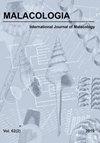Seasonal Dynamics of Oxidative and Antioxidative Parameters in Sadleriana fluminensis (Gastropoda: Hydrobiidae)
IF 1
4区 生物学
Q4 ZOOLOGY
引用次数: 0
Abstract
ABSTRACT This is the first study to document the seasonal dynamics of oxidative and antioxidative parameters in Sadleriana fluminensis (Küster, 1853). Sadleriana fluminensis mostly inhabits spring biotopes, which are threatened by anthropogenic activities. We reported changes in the malondialdehyde (MDA) content, activities of superoxide dismutase (SOD) and catalase (CAT), total antioxidative capacity (TAC), and the qualitative and quantitative composition of the soluble proteins in S. fluminensis. We collected samples from four sites along the longitudinal profile of the Krupa River in three seasons (autumn, winter, and spring). The amount of total soluble proteins and the qualitative protein composition varied seasonally at all sites. Detected protein bands were in the range of 103.8–5.7 kDa in all three seasons, whereas protein bands in the range of 105–60 kDa and 5–10 kDa were not detected in autumn or in spring. In all three seasons, the highest level of MDA was observed upstream at site 1. The values of TAC varied with site and season and were positively correlated to the soluble protein content. SOD activities were highest in winter, followed by autumn and spring; CAT activities were highest in spring, followed by winter and autumn. Principal component analysis based on oxidative and antioxidative parameters revealed marked differences between seasons. The results of this study enhance our understanding of the seasonal dynamics in protein composition and cell redox status within S. fluminensis and will aid future studies. The approach used in this study could also be applied more generally in other ecosystems for the monitoring of bioindicators.河蛙氧化和抗氧化参数的季节动态(腹足目:水螅科)
摘要:这是第一项记录河沙藻氧化和抗氧化参数季节动态的研究(Küster,1853)。河流萨德勒虫主要栖息在春季生物区,受到人类活动的威胁。我们报道了河粉中丙二醛(MDA)含量、超氧化物歧化酶(SOD)和过氧化氢酶(CAT)活性、总抗氧化能力(TAC)以及可溶性蛋白质的定性和定量组成的变化。我们在三个季节(秋季、冬季和春季)从克鲁帕河纵向剖面的四个地点采集了样本。总可溶性蛋白质的量和定性蛋白质组成在所有位点随季节变化。在所有三个季节中,检测到的蛋白质带都在103.8–5.7kDa的范围内,而在秋季或春季没有检测到105–60kDa和5–10kDa的蛋白质带。在所有三个季节中,在1号位点上游观察到最高水平的MDA。TAC值随地点和季节的变化而变化,与可溶性蛋白质含量呈正相关。SOD活性以冬季最高,秋季和春季次之;CAT活动在春季最高,其次是冬季和秋季。基于氧化和抗氧化参数的主成分分析显示,季节之间存在显著差异。这项研究的结果增强了我们对弗氏乳杆菌蛋白质组成和细胞氧化还原状态的季节动力学的理解,并将有助于未来的研究。本研究中使用的方法也可以更广泛地应用于其他生态系统中,用于监测生物指标。
本文章由计算机程序翻译,如有差异,请以英文原文为准。
求助全文
约1分钟内获得全文
求助全文
来源期刊

Malacologia
生物-动物学
CiteScore
2.00
自引率
0.00%
发文量
15
审稿时长
3 months
期刊介绍:
Malacologia publishes papers on all groups of the Mollusca. Malacologia specializes in publishing long papers and monographic treatments. Complete data are especially appreciated. Papers must be of interest to an international readership. Papers in systematics, ecology, population ecology, genetics, molecular genetics, evolution and phylogenetic treatments are especially welcomed. Also welcomed are letters to the editor involving papers published or issues of import to science of the day.
 求助内容:
求助内容: 应助结果提醒方式:
应助结果提醒方式:


